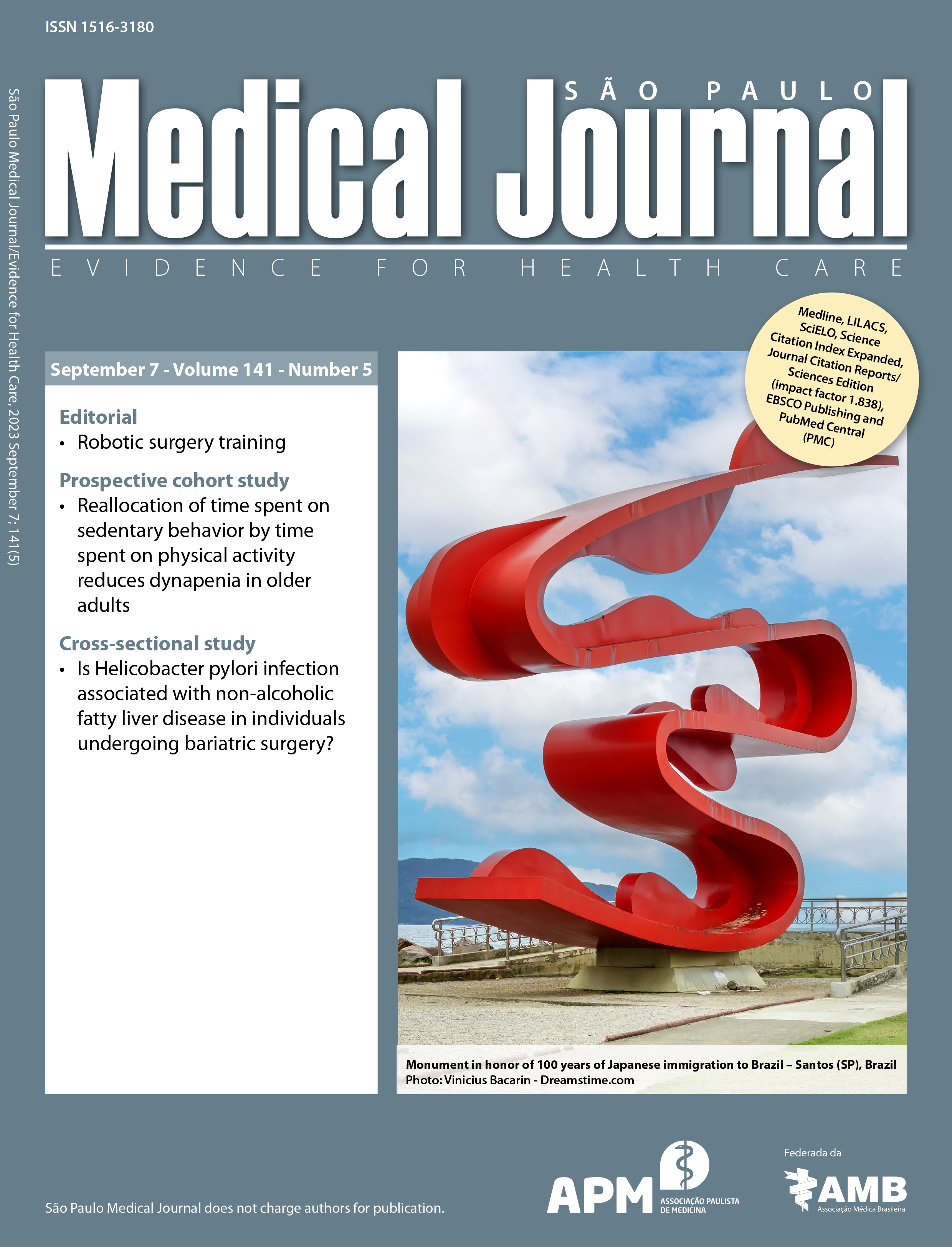Hypertension from the patient’s perspective
contributions to the care offered by health professionals and self-care – a qualitative study
Palavras-chave:
Hypertension, Primary health care, Self care, Qualitative research, Health promotionResumo
BACKGROUND: Hypertension is the most common disease in primary care settings. Only 30% of cases were adequately controlled. OBJECTIVES: To analyze the knowledge and understanding of patients with hypertension regarding the factors that facilitate and limit adherence to treatment and, based on the results, build specific guidelines on hypertension self-care and control. DESIGN AND SETTING: This qualitative study was conducted in a primary healthcare setting. METHODS: Patients with hypertension who were followed at a primary healthcare unit were interviewed through focus groups, and a qualitative interpretation of their statements according to Bardin’s content analysis was performed. RESULTS: Three focus groups were formed (21 participants), from whose analysis emerged 74 core ideas related to the concept of hypertension, causes of increase in blood pressure, clinical consequences of hypertension, and possible patients’ contributions to help control blood pressure, arising from eating habits, psychosocial conditions, and lifestyle. Patients tend to accept the concept of “high blood pressure” as an inherent condition of the disease in their lives. Eating habits are strongly related to life history and self-perception of health. The association between high blood pressure and nervousness or stress appears to be strong. CONCLUSION: The experience of having “pressure problem” is unique for each person. It is necessary to optimize listening, recognizing that, for the patient to understand what hypertension is and its management, there must be understanding and convergence of proposals, adjustments, and changes in a positive and personalized way. As a result of this study, we implemented educational actions in primary healthcare units.
Downloads
Referências
Brasil. Ministério da Saúde. Secretaria de Atenção à Saúde. Departamento de Atenção Básica. Estratégias para cuidado da pessoa com doença crônica: hipertensão arterial sistêmica/Ministério da Saúde, Secretaria da Atenção à Saúde, Departamento de Atenção Básica. Brasília: Ministério da Saúde; 2013. Available from: https://bvsms.saude.gov.br/bvs/publicacoes/estrategias_ cuidado_pessoa_doenca_cronica.pdf. Accessed in 2022 (Oct 21).
Barroso WKS, Rodrigues CIS, Bortolotto LA, et al. Brazilian Guidelines of Hypertension - 2020. Arq Bras Cardiol. 2021;116(3):516-658. PMID: 33909761; https://doi.org/10.36660/abc.20201238.
Nilson EAF, Andrade RDCS, de Brito DA, de Oliveira ML. Custos atribuíveis a obesidade, hipertensão e diabetes no Sistema Único de Saúde, Brasil, 2018 [Costs attributable to obesity, hypertension, and diabetes in the Unified Health System, Brazil, 2018Costos atribuibles a la obesidad, la hipertensión y la diabetes en el Sistema Único de Salud de Brasil, 2018]. Rev Panam Salud Publica. 2020;44:e32. PMID: 32284708; https://doi.org/10.26633/RPSP.2020.32.
Brasil. Ministério da Saúde. Ministério da Saúde. DATASUS. Secretaria de Vigilância em Saúde. Coordenação-Geral de Informações e Análises Epidemiológicas. Sistema de Informações sobre mortalidade (SIM). Available from: http://tabnet.datasus.gov.br/cgi/tabcgi.exe?sim/cnv/obt10uf.def. Accessed in 2022 (Oct 21).
Daniel AC, Veiga EV. Factors that interfere the medication compliance in hypertensive patients. Einstein (São Paulo). 2013;11(3):331-7. PMID: 24136760; https://doi.org/10.1590/s1679-45082013000300012.
Dosse C, Cesarino CB, Martin JF, Castedo MC. Factors associated to patients’ noncompliance with hypertension treatment. Rev Lat Am Enfermagem. 2009;17(2):201-6. PMID: 19551273; https://doi.org/10.1590/S010411692009000200010.
Morgan D. Qualitative research methods: Focus groups as qualitative research. 2nd ed. Thousand Oaks, CA: Sage; 1997.
Bardin L. Análise de Conteúdo. Lisboa: Edições 70; 2002.
Gondim SMG. Grupos focais como técnica de investigação qualitativa: desafios metodológicos. Paidéia (Ribeirão Preto). 2002;12(24):149-61. https://doi.org/10.1590/S0103-863X2002000300004.
Péres DS, Magna JM, Viana LA. Portador de hipertensão arterial: atitudes, crenças, percepções, pensamentos e práticas [Arterial hypertension patients: attitudes, beliefs, perceptions, thoughts and practices]. Rev Saude Publica. 2003;37(5):635-42. PMID: 14569341; https://doi.org/10.1590/S0034-89102003000500014.
Silva LOL, Dias CA, Rodrigues SM, et al. Hipertensão arterial sistêmica: representações sociais de idosos sobre a doença e seu tratamento. Cad Saude Colet. 2013;21(2):121-8. Available from: https://www.scielo.br/j/cadsc/a/PfW6fmPsq8zwcwsF9CzLj3b/abstract/?lang=pt. Accessed in 2022 (May 18).
Fortes AFA, Soane AMNC, Ferreira PAG. Informações sobre hipertensão arterial emergentes de usuários cadastrados no programa HiperDia. Enfermagem Brasil. 2012;11(3):129-37. https://doi.org/10.33233/eb.v11i3.3797
Renovato RD, Dantas AO. Percepção do paciente hipertenso sobre o processo saúde-doença e a terapêutica medicamentosa. Infarma. 2005;17(3/4):72-5. Available from: https://cff.org.br/sistemas/geral/revista/pdf/17/percepAAo.pdf. Accessed in 2022 (May 18).
Fleischer S. “Pressure problems” in Guariroba/Brazil: an anthropological approach to chronic cardiovascular diseases. Cien Saude Colet. 2019;24(7):2617-26. PMID: 31340279; https://doi.org/10.1590/1413-81232018247.15802017.
Brito DM, Araújo TL, Galvão MT, Moreira TM, Lopes MV. Qualidade de vida e percepção da doença entre portadores de hipertensão arterial [Quality of life and perception of illness among individuals with hihg blood pressure]. Cad Saude Publica. 2008;24(4):933-40. PMID: 18392372; https://doi.org/10.1590/s0102311x2008000400025.
Silva RAR, Sakon POR. Autopercepção do estado de saúde de hipertensos. Rev Enferm UFPE (online). 2018;12(7):1826-34. Available from: https://pesquisa.bvsalud.org/portal/resource/pt/biblio-986525. Accessed in 2022 (May 18).
Lima MT, Bucher JS, Lima JW. A hipertensão arterial sob o olhar de uma população carente: estudo exploratório a partir dos conhecimentos, atitudes e práticas [Hypertension from the perspective of a low-income population: na exploratory study of knowledge, atitudes, and practices]. Cad Saude Publica. 2004;20(4):1079-87. PMID: 15300301; https://doi.org/10.1590/s0102-311x2004000400023.
Firmo JO, Lima-Costa MF, Uchôa E. Projeto Bambuí: maneira de pensar e agir de idosos hipertensos [The Bambuí Health and Aging Study (BHAS): ways of thinking and acting among hypertensive older adults]. Cad Saude Publica. 2001;20(4):1029-40. PMID: 15300296; https://doi.org/10.1590/S0102-311X2004000400018.
Pierin AMG, Mion Jr D, Fukushima JT, Pinto AR, Kaminaga MM. O perfil de um grupo de pessoas hipertensas de acordo com conhecimento e gravidade da doença. Rev Esc Enferm USP. 2001;35:11-8. Available from: https://www.scielo.br/j/reeusp/a/CcDxQDkK4kWNRfphZb3xJnP/?format=pdf&lang=pt. Accessed in 2022 (May 18).
Lerri MR, Oliveira CM, Shuhama R. Percepção de pacientes diabéticos e hipertensos usuários de um Núcleo de Saúde da Família. Saude Transf Soc. 2013;4(4):63-8. Available from: http://pepsic.bvsalud.org/scielo.php?script=sci_arttext&pid=S2178-70852013000400011&lng=pt&nrm=iso. Accessed in 2022 (May 18).
Silva JP, Silva MLB, Bousfield ABS. Representações sociais da hipertensão, do convívio e tratamento da doença. Psicol Argum. 2019;37(98):433-52. https://doi.org/10.7213/psicolargum.37.98.AO02.
Fava SMCL, Zago MMF, Nogueira MS, Dázio EMR. Experiência da doença e do tratamento para a pessoa com hipertensão arterial sistêmica: um estudo etnográfico. Rev Lat-Am Enferm. 2013;21(5):1022-9. Available from: https://www.redalyc.org/pdf/2814/281428540003.pdf. Accessed in 2022 (May 18).
Downloads
Publicado
Como Citar
Edição
Seção
Licença

Este trabalho está licenciado sob uma licença Creative Commons Attribution 4.0 International License.





